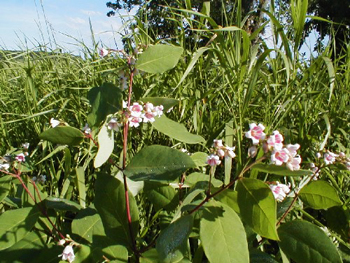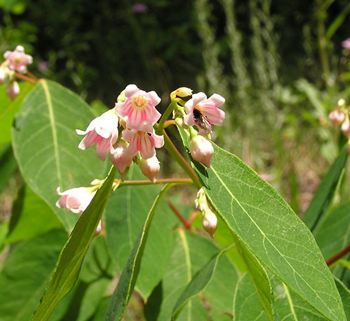Contents:
Common Names | Parts Usually Used | Plant(s) & Culture | Where Found | Medicinal Properties
Legends, Myths and Stories | Uses | Formulas or Dosages | Warning | Bibliography
Scientific Names

- Apocynum androsaemifolium L.
- Apocynaceae
- Order Gentianales
- Dogbane family
Common Names
- Bitterroot
- Catchfly
- Flytrap
- Honeybloom
- Milk ipecac
- Milkweed
- Mountain hemp
- Spreading dogbane
- Wallflower
- Wandering milkweed
- Westernwall
- Western wallflower
Parts Usually Used
Rootstock and dried rhizome. Not to be used without medical supervision.
Back to Top

Description of Plant(s) and Culture
Designating a family of dictyledonous herbs, shrubs, and trees, including frangipani and periwinkle.
Dogbane is a bushy, shrub-like, perennial, hairless plant with tough fibrous bark on the stems, exuding milky latex juice when broken.
A large, horizontal, milky rootstock sends up a glabrous stem with tough, fibrous bark to a height of 1-4 feet. The leaves are opposite, roundish to oblong-ovate or ovate, dark green above, lighter and hairy beneath, and grow on short, reddish petioles. The nodding bell-shaped, drooping, fragrant flowers grow in terminal cymes and are pink outside, pink and white striped inside or pink with red markings inside. Blooming time is May to August. The fruit is a pair of long, slender pods. All parts of the plant contain a milky juice.
This plant, dogbane, differs from its close relative Indian Hemp (A. cannabinum) in that its leaves are mostly sessile (stalkless), and the flowers are both in leaf axils and terminal.
Another plant is also called bitterroot (Lewisia rediviva) was commonly eaten by the Native Americans in Montana.
Back to Top
Where Found
Dogbane is a native perennial plant found in both the Atlantic and Pacific coastal states, in dry, sandy soils and around the edges of forests. Less commonly on roadsides and in fields. Newfoundland to Georgia and Arizona. Absent from Kansas and south of North Carolina highlands.
Back to Top
Medicinal Properties
Cathartic, diaphoretic, emetic, expectorant, laxative, stimulant, tonic
Back to Top
Legends, Myths and Stories
Dogbane is so named, they say, because it is said to be poisonous to dogs.
In North America there are 60 species.
No side effects have been found from the proper administration under medical guidance.
Not recommended for use without medical direction.
Back to Top
Uses
Dogbane has been used to relieve dyspepsia, constipation, fever, gallstones, and dropsy. Used in treatment of liver disorders. Given in large doses, it is cathartic and emetic and may cause other symptoms of poisoning. When used, it is generally combined with less harsh medications suitable for the intended purpose.
A diuretic in dropsy after heart failure. Hemp dogbane is used in medicine in the treatment of heart failure but even in small doses it is dangerous.
Native Americans used the root of dogbane for many ailments. It induces sweating and vomiting; laxative. Used in headaches with sluggish bowels and syphilis.
Back to Top
Formulas or Dosages
Infusion: Steep 1 tsp. rootstock in 1 pint of boiling water. Take cold, 2 to 3 tsp. 6 times per day.
Tincture: take 5 to 10 drops in water before meals.
Back to Top
Warning
Poisonous. Cymarin, a cardioactive glycoside, poisons cattle. Eating the leaves has killed the livestock. The milky sap has been used safely externally as a remedy.
The plant has shown anti-tumor activity.
Not recommended for use without medical direction.
Back to Top
Bibliography
 How Indians Use Wild Plants for Food, Medicine & Crafts
How Indians Use Wild Plants for Food, Medicine & Crafts, by Frances Densmore, Dover Publications, Inc., 180 Varick Street, New York, NY 10014, first printed by the United States Government Printing Office, Washington, in 1928, this Dover edition 1974
![]() Eastern/Central Medicinal Plants
Eastern/Central Medicinal Plants, by Steven Foster and James A. Duke., Houghton Mifflin Company, 215 Park Avenue South, New York, NY 10000
![]() American Folk Medicine
American Folk Medicine, by Clarence Meyer, Meyerbooks, publisher, PO Box 427, Glenwood, Illinois 60425, 1973
![]() Planetary Herbology
Planetary Herbology, by Michael Tierra, C.A., N.D., O.M.D., Lotus Press, PO Box 325, Twin Lakes. WI 53181., Copyright 1988, published 1992
![]() Indian Herbalogy of North America
Indian Herbalogy of North America, by Alma R. Hutchens, Shambala Publications, Inc., Horticultural Hall, 300 Massachusetts Avenue, Boston, Massachusetts 02115, 1973
![]() Webster’s New World Dictionary
Webster’s New World Dictionary, Third College Edition, Victoria Neufeldt, Editor in Chief, New World Dictionaries: A Division of Simon & Schuster, Inc., 15 Columbus Circle, New York, NY 10023
 An Instant Guide to Medicinal Plants
An Instant Guide to Medicinal Plants, by Pamela Forey and Ruth Lindsay, Crescent Books (January 27, 1992).
 The Rodale Herb Book: How to Use, Grow, and Buy Nature’s Miracle Plants (An Organic gardening and farming book)
The Rodale Herb Book: How to Use, Grow, and Buy Nature’s Miracle Plants (An Organic gardening and farming book), edited by William H. Hylton, Rodale Press, Inc. Emmaus, PA, 18049., 1974
